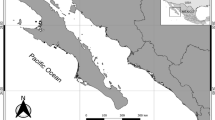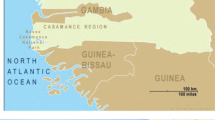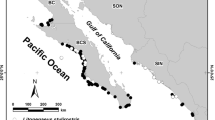Abstract
It has been emphasized that seafood consumers may have a higher risk of mercury (Hg) exposure. Nevertheless, the co-occurrence of selenium (Se) in organisms may affect the toxicity and bioavailability of Hg. In this work, we aim to demonstrate the possible role of Se as a potential protective element against Hg in muscle and liver tissues of three demersal deep-sea fish species: common mora Mora moro, birdbeak dogfish Deania calcea, and smooth lanternshark Etmopterus pusillus. Comparing species, the birdbeak dogfish D. calcea showed the highest Hg concentrations, the lowest Se levels, the lowest mean Se:Hg molar ratio, a negative HBV-Se index, and no correlation between total length. On the other hand, smooth lanternshark E. pusillus showed the lowest Hg concentrations, the highest Se concentrations, the highest mean Se:Hg molar ratio, a positive HBV-Se index, and a significant positive correlation between total length and Se concentrations in muscle. Comparing tissues, the common mora Mora moro seems to accumulate more Hg and Se in liver than shark species D. calcea and E. pusillus that showed to accumulate Hg and Se preferentially in muscle. Our results indicate that these three species for having Hg concentrations near and above the EU regulatory thresholds and for presenting low Se:Hg ratios, and negative (or low positive) HBV-Se index may pose a real risk of Hg toxicity for the consumer.


Similar content being viewed by others
Change history
06 July 2020
The correct Table 2 is presented in this paper.
References
Ahmad NI et al (2015) Mercury levels of marine fish commonly consumed in Peninsular Malaysia. Environ Sci Pollut Res Int 22:3672–3686. https://doi.org/10.1007/s11356-014-3538-8
Anderson MJ, Gorley RN, Clarke KR (2008) PERMANOVA + for PRIMER: guide to software and statistical methods. PRIMER-E, Plymouth
Annibaldi A, Truzzi C, Carnevali O, Pignalosa P, Api M, Scarponi G, Illuminati S (2019) Determination of hg in farmed and wild Atlantic Bluefin tuna (Thunnus thynnus L.) muscle. Molecules 24:1273. https://doi.org/10.3390/molecules24071273
Azad AM, Frantzen S, Bank MS, Nilsen BM, Duinker A, Madsen L, Maage A (2019) Effects of geography and species variation on selenium and mercury molar ratios in Northeast Atlantic marine fish communities. Sci Total Environ 652:1482–1496. https://doi.org/10.1016/j.scitotenv.2018.10.405
Beltran-Pedreros S, Zuanon J, Leite RG, Peleja JRP, Mendonça AB, Forsberg BR (2011) Mercury bioaccumulation in fish of commercial importance from different trophic categories in an Amazon floodplain lake. Neotrop Ichthyol 9:901–908
Biton-Porsmoguer S et al (2018) Mercury in blue shark (Prionace glauca) and shortfin mako (Isurus oxyrinchus) from North-Eastern Atlantic: implication for fishery management. Mar Pollut Bull 127:131–138. https://doi.org/10.1016/j.marpolbul.2017.12.006
Boening DW (2000) Ecological effects, transport, and fate of mercury: a general review. Chemosphere 40:1335–1351
Branco V, Canário J, Vale C, Raimundo J, Reis C (2004) Total and organic mercury concentrations in muscle tissue of the blue shark (Prionace glauca L.1758) from the Northeast Atlantic. Mar Pollut Bull 49:854–874
Branco V, Vale C, Canário J, Santos MN (2007) Mercury and selenium in blue shark (Prionace glauca, L. 1758) and swordfish (Xiphias gladius, L. 1758) from two areas of the Atlantic Ocean. Environ Pollut 150:373–380. https://doi.org/10.1016/j.envpol.2007.01.040
Burger J, Gochfeld M (2013) Selenium and mercury molar ratios in commercial fish from New Jersey and Illinois: Variation within species and relevance to risk communication. Food Chem Toxicol 57:235–245. https://doi.org/10.1016/j.fct.2013.03.021
Burger J, Gochfeld M, Jeitner C, Donio M, Pittfield T (2012) Selenium:mercury molar ratios in freshwater fish from Tennessee: individual, species, and geographical variations have implications for management. EcoHealth 9:171–182. https://doi.org/10.1007/s10393-012-0761-y
Cabañero AI, Madrid Y, Cámara C (2007) Mercury–Selenium Species Ratio in Representative Fish Samples and Their Bioaccessibility by an In Vitro Digestion Method. Biol Trace Elem Res 119:195–211. https://doi.org/10.1007/s12011-007-8007-5
Cecilio P, Raimundo J, Canario J, Vale C, Sequeira M (2006) Relationships between total and organic mercury concentrations in tissues and length of common dolphins (Delphinus delphis) from the Portuguese coast. Cienc Mar 32:379–387. https://doi.org/10.7773/cm.v32i22.1094
Cossa D et al (2012) Influences of bioavailability, trophic position, and growth on Methylmercury in hakes (Merluccius merluccius) from northwestern Mediterranean and Northeastern Atlantic. Environ Sci Technol 46:4885–4893. https://doi.org/10.1021/es204269w
Dorea JG, Moreira MB, East G, Barbosa AC (1998) Selenium and mercury concentrations in some fish species of the Madeira River, Amazon Basin, Brazil. Biol Trace Elem Res 65:211–220. https://doi.org/10.1007/bf02789097
El-Moselhy KM, Othman AI, Abd El-Azem H, El-Metwally MEA (2014) Bioaccumulation of heavy metals in some tissues of fish in the Red Sea, Egypt. Egypt J Basic Appl Sci 1:97–105. https://doi.org/10.1016/j.ejbas.2014.06.001
Endo T, Hisamichi Y, Haraguchi K, Kato Y, Ohta C, Koga N (2008) Hg, Zn and Cu levels in the muscle and liver of tiger sharks (Galeocerdo cuvier) from the coast of Ishigaki Island, Japan: Relationship between metal concentrations and body length. Mar Pollut Bull 56:1774–1780. https://doi.org/10.1016/j.marpolbul.2008.06.003
Escobar-Sánchez O, Galván-Magaña F, Rosíles-Martínez R (2011) Biomagnification of Mercury and Selenium in Blue Shark Prionace glauca from the Pacific Ocean off Mexico. Biol Trace Elem Res 144:550–559. https://doi.org/10.1007/s12011-011-9040-y
García-Hernández J, Cadena-Cárdenas L, Betancourt-Lozano M, García-De-La-Parra LM, García-Rico L, Márquez-Farías F (2007) Total mercury content found in edible tissues of top predator fish from the Gulf of California, Mexico. Toxicol Environ Chem 89:507–522. https://doi.org/10.1080/02772240601165594
Giacomello E, Menezes GM, Bergstad OA (2013) An integrated approach for studying seamounts: CONDOR observatory. Deep-Sea Res II Top Stud Oceanogr 98:1–6. https://doi.org/10.1016/j.dsr2.2013.09.023
Harmelin-Vivien M, Cossa D, Crochet S, Bănaru D, Letourneur Y, Mellon-Duval C (2009) Difference of mercury bioaccumulation in red mullets from the north-western Mediterranean and Black seas. Mar Pollut Bull 58:679–685. https://doi.org/10.1016/j.marpolbul.2009.01.004
Kaneko JJ, Ralston NVC (2007) Selenium and Mercury in Pelagic Fish in the Central North Pacific Near Hawaii. Biol Trace Elem Res 119:242–254. https://doi.org/10.1007/s12011-007-8004-8
Lavoie RA, Jardine TD, Chumchal MM, Kidd KA, Campbell LM (2013) Biomagnification of Mercury in Aquatic Food Webs: A Worldwide Meta-Analysis. Environ Sci Technol 47:13385–13394. https://doi.org/10.1021/es403103t
Li P, Feng X, Qiu G (2010) Methylmercury exposure and health effects from rice and fish consumption: a review. Int J Environ Res Public Health 7:2666–2691. https://doi.org/10.3390/ijerph7062666
Magnússon JV (2001) Distribution and some other biological parameters of two morid species Lepidion eques (Günther, 1887) and Antimora rostrata (Günther, 1878) in Icelandic waters. Fish Res 51:267–281
Martins I, Costa V, Porteiro FM, Colaço A, Santos RS (2006) Mercury concentrations in fish species caught at Mid-Atlantic Ridge hydrothermal vent fields. Mar Ecol Prog Ser 320:253–258. https://doi.org/10.3354/meps320253
Mason RP, Choi AL, Fitzgerald WF, Hammerschmidt CR, Lamborg CH, Soerensen AL, Sunderland EM (2012) Mercury biogeochemical cycling in the ocean and policy implications. Environ Res 119:101–117. https://doi.org/10.1016/j.envres.2012.03.013
Maz-Courrau A, López-Vera C, Galván-Magaña F, Escobar-Sánchez O, Rosíles-Martínez R, Sanjuán-Muñoz A (2012) Bioaccumulation and biomagnification of Total mercury in four exploited shark species in the Baja California Peninsula, Mexico. Bull Environ Contam Toxicol 88:129–134. https://doi.org/10.1007/s00128-011-0499-1
Newman MC, Xu X, Cotton CF, Tom KR (2011) High Mercury Concentrations Reflect Trophic Ecology of Three Deep-Water Chondrichthyans. Arch Environ Contam Toxicol 60:618–625. https://doi.org/10.1007/s00244-010-9584-4
Penedo de Pinho A, Guimarães JRD, Martins AS, Costa PAS, Olavo G, Valentin J (2002) Total mercury in muscle tissue of five shark species from Brazilian offshore waters: effects of feeding habit, Sex, and Length. Environ Res 89:250–258. https://doi.org/10.1006/enrs.2002.4365
Pethybridge H, Cossa D, Butler ECV (2010) Mercury in 16 demersal sharks from Southeast Australia: biotic and abiotic sources of variation and consumer health implications. Mar Environ Res 69:18–26. https://doi.org/10.1016/j.marenvres.2009.07.006
Polak-Juszczak L (2015) Selenium and mercury molar ratios in commercial fish from the Baltic Sea: additional risk assessment criterion for mercury exposure. Food Control 50:881–888. https://doi.org/10.1016/j.foodcont.2014.10.046
Raimundo J, Vale C, Caetano M, Giacomello E, Anes B, Menezes GM (2013) Natural trace element enrichment in fishes from a volcanic and tectonically active region (Azores archipelago). Deep-Sea Res II Top Stud Oceanogr 98:137–147. https://doi.org/10.1016/j.dsr2.2013.02.009
Ralston NVC (2008) Selenium Health Benefit Values as Seafood Safety Criteria. EcoHealth 5:442–455. https://doi.org/10.1007/s10393-008-0202-0
Ralston NVC, Raymond LJ (2010) Dietary selenium's protective effects against methylmercury toxicity. Toxicology 278:112–123. https://doi.org/10.1016/j.tox.2010.06.004
Ralston NVC, Raymond LJ (2011) Dietary selenium's protective effects against methylmercury toxicity (vol 278, pg 112, 2010). Toxicology 289:185–185. https://doi.org/10.1016/j.tox.2011.08.010
Ralston NVC, Ralston CR, Raymond LJ (2016) Selenium Health Benefit Values: Updated Criteria for Mercury Risk Assessments. Biol Trace Elem Res 171:262–269. https://doi.org/10.1007/s12011-015-0516-z
Raymond LJ, Ralston NVC (2009) Selenium's importance in regulatory issues regarding mercury. Fuel Process Technol 90:1333–1338. https://doi.org/10.1016/j.fuproc.2009.07.012
Sackett DK, Aday DD, Rice JA, Cope WG, Buchwalter D (2010) Does proximity to coal-fired power plants influence fish tissue mercury? Ecotoxicology 19:1601–1611. https://doi.org/10.1007/s10646-010-0545-5
Spiller HA (2018) Rethinking mercury: the role of selenium in the pathophysiology of mercury toxicity. Clin Toxicol 56:313–326. https://doi.org/10.1080/15563650.2017.1400555
Storelli M, Giacominelli-Stuffler R, Marcotrigiano G (2002) Total and methylmercury residues in cartilaginous fish from Mediterranean Sea. Mar Pollut Bull 44:1354–1358
Suratno S, Puspitasari R (2018) Health benefit value selenium (HBV-se): a food safety index from mercury (Hg) contamination in marine fish consumption. AIP Conf Proc 2024:020023. https://doi.org/10.1063/1.5064309
Walters K, Coen LD (2006) A comparison of statistical approaches to analyzing community convergence between natural and constructed oyster reefs. J Exp Mar Biol Ecol 330:81–95. https://doi.org/10.1016/j.jembe.2005.12.018
Wang X et al (2018) Mercury concentrations and Se:Hg molar ratios in Flyingfish (Exocoetus volitans) and squid (Uroteuthis chinensis). Bull Environ Contam Toxicol 101:42–48. https://doi.org/10.1007/s00128-018-2369-6
Funding
This work was conducted under the framework of the projects CONDOR (PT-0040), co-financed by a Grant from Iceland, Liechtenstein, Norway through the EEA Financial Mechanism, SMaRT financed by SRECC (ref. M.2.1.2/029/2011) and SEAMOV (PTDC/MAR/108232/2008). We are grateful to all the crew members of the RV “Arquipélago” for their invaluable help during fishing operations. Data collection would not have been possible without the contribution of all the participants on the cruises in particular to Alexandra Rosa, Diana Catarino, and Eva Giacomello. The authors also would like to thank Luis Pires for his collaborative support during lab work. This study had the support of Fundação para a Ciência e Tecnologia (FCT), through the strategic project UID/MAR/04292/2013 granted to MARE. IM and JR received finance from SFRH/BPD/73481/2010 and SFRH/BPD/91498/2012 postdoctoral grant, respectively.
Author information
Authors and Affiliations
Contributions
Conceptualization: IM, MP, and JR; methodology: GT, IM, VC, and JR.; investigation: IM, MP, and GM; writing, original draft: GT, JG, and IM; writing, review, and editing: all the authors; funding acquisition: GM; Supervision: IM and MP.
Corresponding author
Additional information
Responsible editor: Vedula VSS Sarma
Publisher’s note
Springer Nature remains neutral with regard to jurisdictional claims in published maps and institutional affiliations.
The original article was revised: The correct Table 2 is presented in this paper.
Rights and permissions
About this article
Cite this article
Teixeira, G., Raimundo, J., Goulart, J. et al. Hg and Se composition in demersal deep-sea fish from the North-East Atlantic. Environ Sci Pollut Res 27, 33649–33657 (2020). https://doi.org/10.1007/s11356-020-08970-3
Received:
Accepted:
Published:
Issue Date:
DOI: https://doi.org/10.1007/s11356-020-08970-3




